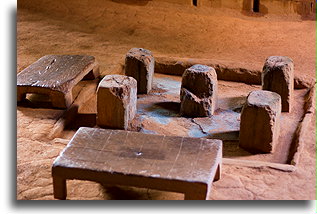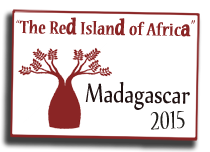Ambohimanga
January 17
Driving in extremely slow-moving traffic, we reach the capital's outskirts. Ambohimanga, located 30 km from the city, is the hill, which belonged to the Merina tribe and was a royal settlement. In the pouring rain, we reached the walls of the well-preserved complex of buildings. The place is probably the most significant symbol of Malagasy identity. This palace built long before France colonized Madagascar to this day, serves as a sacred, nationalistic symbol.


In the courtyard, in close proximity to the main gate, is a spiritually important place for the Malagasy. Pilgrims come here often to offer prayers and even sacrifice live animals. I wanted to get closer to see sacrificed Zebu skulls and horns that decorated the old fig tree like trophies. A guard told me that it is a holy ground, and if I want to approach closer, I need to take my shoes off. Unfortunately, after the rain this holy ground turned out to be a large muddy puddle. Seeing this, I decided to abandon the idea of walking there barefoot.


According to oral history, it is estimated that sixteen million eggs were used for whitewash that covers high walls in the main complex. It was a time when the consumption of eggs by the commoners was forbidden. The eggs were a form of payment for mandatory taxes. As you can see, it makes sense to collect taxes for the important purpose. The walls preserved the white color to this day.


Inside the royal complex, buildings are built in different architectural styles. The oldest is a traditional wooden dwelling of the Central Highlands of Madagascar. The old royal palace is similar to ordinary Zafimaniry house, which we visited a few days earlier. It is dark inside; tiny window openings have no glass. The five rectangular stones in the dirt floor mark the space for wood fire. The interior differs from the hut of ordinary people only in a fact that there are bunks. The Lord and his wife did not sleep on the floor like common people, but in the wooden bunks lined with hay. The stories we heard indicated that the king used to climb high up under the roof when guests were expected. This way he could hear what newcomers were saying, while remaining invisible. This maneuver was necessary because the rulers of the time constantly feared assassins. According to old customs, everyone entering the old palace is required to step in with the right foot. Exiting is more difficult, as it should be done backwards, starting with the left leg.



There are completely different two colorful pavilions from the second half of the 19th century. Built in a foreign style, filled with European furniture, and surrounded by glass windows, they seem as if they were transferred here from another world. Directly above them are small wooden houses without windows with soaring roofs. These are the royal tombs.

In the highest part of the royal complex, we found two large pools carved out of the rock. According to the tradition, during the New Year festival (based on the Muslim calendar), the monarch took his bath here. It was a ritual of purification, but in reality, it was the so-called "big bath, which consisted of soaking the whole body once a year. On a daily basis, a "small bath" consisting only of washing hands, sometimes the face is a way of washing often practiced in Madagascar even today.



The next day we had scheduled flights out of Madagascar. I called Coen and arranged Pajero return at the airport. Matt was flying back home to his college. He had interviews scheduled for summer internships. Eva and I were going to Mauritius, another island in Africa.









